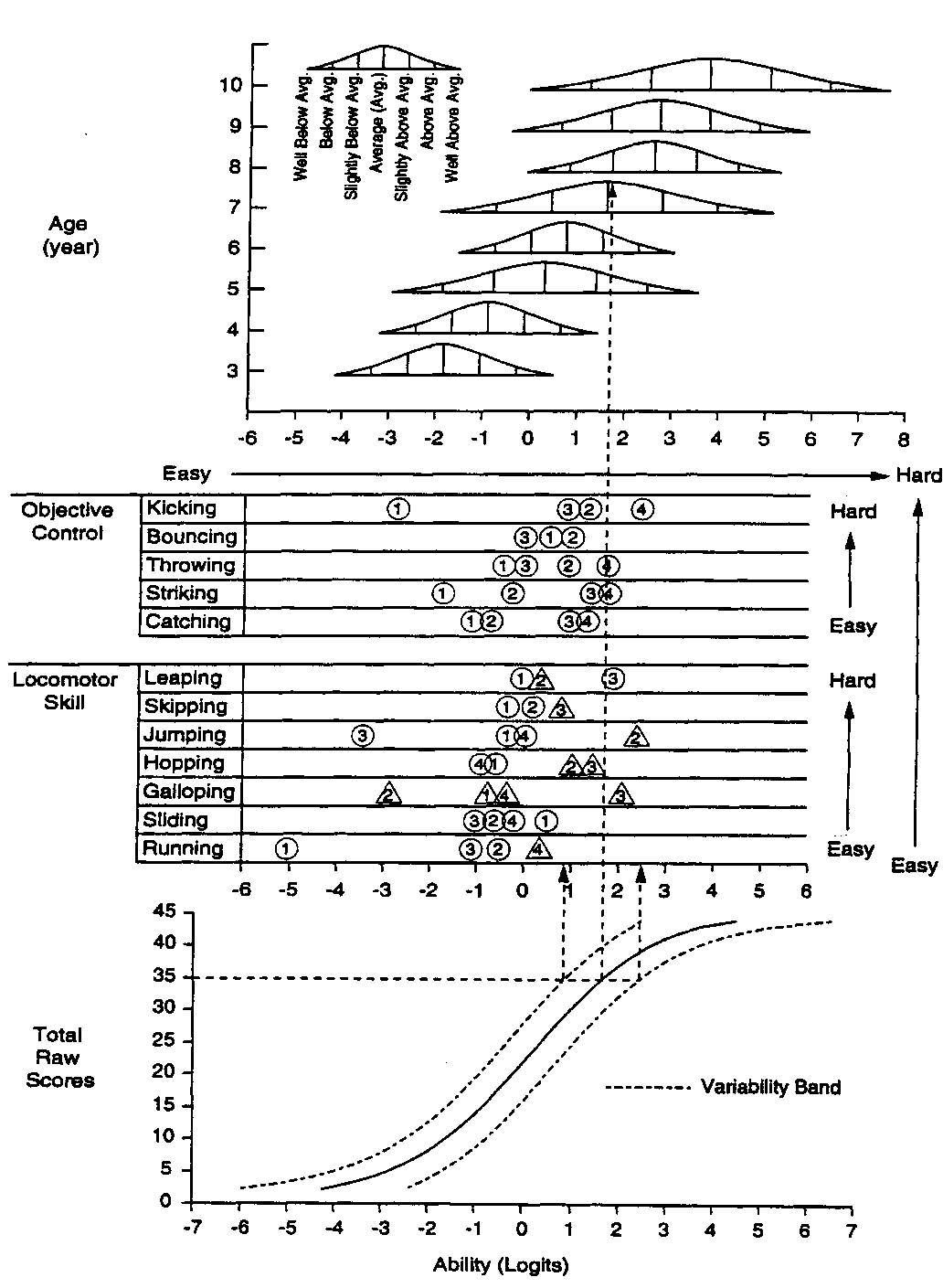
An innovative and powerful way to communicate measurement information is displayed overleaf. It comes from W. Zhu and E.L. Cole, Many-facet Rasch calibration of a gross-motor instrument, to appear in Research Quarterly for Exercise and Sport.
The item map is in the center of the picture (in printed text). There are two content areas in Ulrich's "Test of Gross Motor Development": Objective Control and Locomotor Skill. Within each area there are several strands: Kicking, Bouncing, Throwing, etc. Within each strand there are several test items. For Kicking, they are 1, 2, 3, 4. Each test item is positioned at its logit calibration. There are some easy Kicking, Jumping, Galloping and Running items, but no especially hard ones. (For general use, the logit scale could be linearly transformed into "GroMo" units, with a conversion GroMo = 6*logit + 47. Then the displayed range across the page would be 5 to 95, instead of -7 to +8.)
To use this map as a self-measuring instrument, mark an / or x at each item administered to the child directly onto the item map. (The printed item map shows what happened when a child was administered the whole test: each success is marked with a (), each failure with a ^.) Then draw by eye a vertical line down the map summarizing the child's overall level of performance on the test. (The dotted line shown on the map does this for the example child). A / or x placed far from the vertical line flags an unexpected strength or weakness. (The ^ on Item 2 in Galloping is a conspicuous weakness of the example child).
Extend your vertical line down to meet the familiar ogival test characteristic curve in the bottom panel. This is positioned to align with the measurement scale of the central panel. Now you can read off a predicted raw score on the complete test, even when only a few items have been administered!
Extend your vertical line up to the normative curves in the top panel, which are a series of person maps summarizing the typical range of child performances at each year of age. The vertical line in the picture identifies a 7 year-old performing slightly above average. Note how, in Ulrich's data, the 6 year-olds were more homogeneous than the 5 or 7 year-olds. This reminds us that normative curves are based on samples and so are never completely general "truths".
The symbols in the center panel of the Figure are test items.

Communication measurement. Zhu W. … Rasch Measurement Transactions, 1995, 9:2 p.437
| Forum | Rasch Measurement Forum to discuss any Rasch-related topic |
Go to Top of Page
Go to index of all Rasch Measurement Transactions
AERA members: Join the Rasch Measurement SIG and receive the printed version of RMT
Some back issues of RMT are available as bound volumes
Subscribe to Journal of Applied Measurement
Go to Institute for Objective Measurement Home Page. The Rasch Measurement SIG (AERA) thanks the Institute for Objective Measurement for inviting the publication of Rasch Measurement Transactions on the Institute's website, www.rasch.org.
| Coming Rasch-related Events | |
|---|---|
| Jan. 16 - Feb. 13, 2025, Fri.-Fri. | On-line workshop: Rasch Measurement - Core Topics (E. Smith, Winsteps), www.statistics.com |
| Apr. 8 - Apr. 11, 2026, Wed.-Sat. | National Council for Measurement in Education - Los Angeles, CA, ncme.org/events/2026-annual-meeting |
| Apr. 8 - Apr. 12, 2026, Wed.-Sun. | American Educational Research Association - Los Angeles, CA, www.aera.net/AERA2026 |
| May. 15 - June 12, 2026, Fri.-Fri. | On-line workshop: Rasch Measurement - Core Topics (E. Smith, Winsteps), www.statistics.com |
| June 19 - July 25, 2026, Fri.-Sat. | On-line workshop: Rasch Measurement - Further Topics (E. Smith, Winsteps), www.statistics.com |
The URL of this page is www.rasch.org/rmt/rmt92p.htm
Website: www.rasch.org/rmt/contents.htm